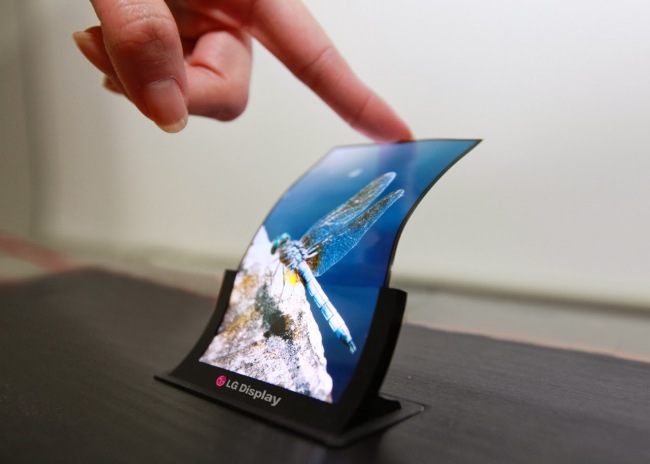The two Korean tech giants Samsung and LG will beef up their production of organic light-emitting diode displays as their liquid-crystal display earnings are at risk due to competition from cheaper Chinese rivals.
According to market research firm IHS, the global flat panel display industry, jolted by an oversupply of LCD panels, is forecast to see a 2 percent decline in sales from $131.4 billion in 2014 to $129 billion this year.
In the meantime, OLED is the only display technology expected to grow in 2015, the firm said, adding active-matrix OLED, or AMOLED, display revenues are projected to reach $11.8 billion in 2015, up 36 percent from 2014.

LG Display's plastic flexible OLED
“The entire flat panel display supply chain now must shift focus from growth to cost reduction in order to maintain profitability,” said David Hsieh, senior director of display research for IHS.
He cited several factors behind the AMOLED growth, such as soaring OLED display shipments for smartphones, growth in OLED TV panel shipments, the expansion of OLED into tablet PCs and growing use in wearable devices like Apple Watch.
Samsung and LG, the world’s top display makers that overtook flat-screen pioneer Japan in the early 2000s, are also betting big on OLED, especially flexible OLED, to maintain an edge over Chinese companies.
“Flexible OLED is a key feature driving AMOLED revenues, especially given its higher ASP (average sales price), attractive features and great value,” the IHS researcher said.
Unlike LCDs, which rely on a separate light source behind the screen, OLEDs illuminate themselves, resulting in far slimmer and lighter displays. This allows deeper blacks and richer colors.
But OLEDs are a lot tougher to produce than LCDs, which affects both the supply and pricing.
Samsung Display, which has backed away from OLED TVs due to production constraints of large OLEDs, is a leader in making smaller-sized OLEDs for mobile phones, which it uses in its Galaxy smartphone line and sells to Chinese handset makers.
Largely buoyed by the popularity of its curved-screen Galaxy S6 Edge smartphone, the company plans to increase flexible OLED productions from the current 39,000 units per month to 63,000 units by the first quarter of next year.
The company invested 1.6 trillion won ($1.4 billion) in its display business alone in the first half of this year, and is said to be considering an additional 2 trillion won investment in the latter half especially for OLED.
“We have solved production issues now. We plan to expand sales channels of flexible OLEDs to meet the market demands,” said Lee Chang-hoon, a Samsung Display executive, at a conference call last week.
LG Display, the world’s largest maker of larger displays, which has focused on producing OLED TVs, will also pour more resources into smaller OLEDs for smartphones and other mobile devices.
The company recently decided to inject 1.05 trillion won in its Gumi plant in North Gyeongsang Province to produce 7,500 units of flexible OLED panels per month from 2017.
The fresh investment is expected to pave the way for the company to lead future markets for foldable displays and its diverse adoption on smartphones, wearable devices and automotive displays.
By Lee Ji-yoon (
jylee@heraldcorp.com)

![[Exclusive] Korean military set to ban iPhones over 'security' concerns](http://res.heraldm.com/phpwas/restmb_idxmake.php?idx=645&simg=/content/image/2024/04/23/20240423050599_0.jpg&u=20240423183955)

![[Graphic News] 77% of young Koreans still financially dependent](http://res.heraldm.com/phpwas/restmb_idxmake.php?idx=645&simg=/content/image/2024/04/22/20240422050762_0.gif&u=)


